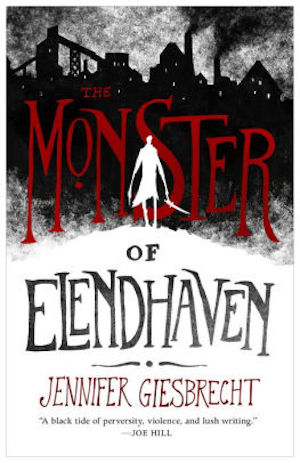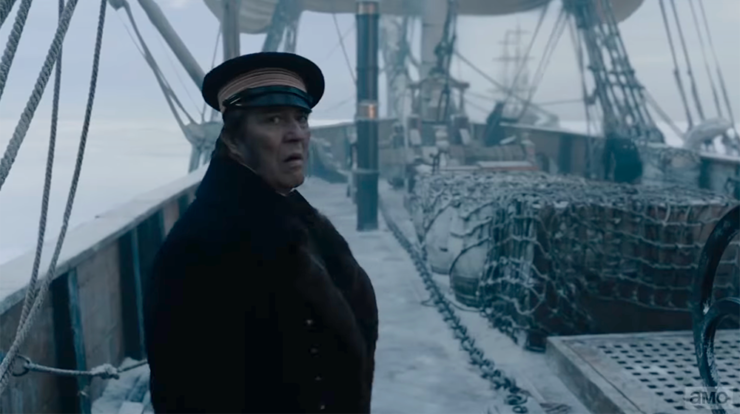On August 29, 2019, Parks Canada released a stunning video of the interior of one of Sir John Franklin’s lost ships, HMS Terror. In the first detailed exploration since the wreck was rediscovered in 2016, archaeologists sent a remote drone to explore the wreck and found a stunningly well-preserved ship—“frozen in time” as the inevitable phrase goes—that almost looks as if the crew simply walked quietly away one day. There are plates still on the shelves; a chamber-pot remains on the floor of an officer’s cabin; and Captain Francis Crozier’s desk and chair stand upright under a soft coat of ocean sediment.
This was obviously big news for history nerds and aficionados of the Royal Navy Discovery Service’s misadventures, but it was also big news for fans of AMC’s The Terror. When The Terror Series 1 premiered in 2018, it passed under the radar for many, but over the last year it has picked up a long tail of devotees. Its release on Hulu brought a new round of attention, stoked further by August’s premiere of Series 2, otherwise known as The Terror: Infamy, as AMC made the (arguably questionable) decision to take the title The Terror and turn it into an anthology series.
(Here, The Terror will refer to Series 1 only, and The Terror: Infamy or Infamy to Series 2.)
Of The Terror: Infamy I will have more to say in a few weeks; we’re about halfway through the series, and I’d prefer to reserve judgement until I have the big picture to work with. Suffice it for now to say that it is a well-intentioned endeavor with a commitment to verisimilitude that honors its all-too-timely subject, the World War II internment of Japanese-American citizens under Executive Order 9066. If there’s a throughline between The Terror and Infamy, it’s that while supernatural horrors may be terrifying and deadly, what men perpetrate on one another in the name of fear or desperation is as bad or worse. The details of how that ultimately plays out in Infamy are a work in progress.
In the meantime, I’m going to make the case as to why you should fit the original series of The Terror into your busy fall TV schedule.
The Terror—which I have not-entirely-jokingly described as The Thing meets Master and Commander—was adapted for TV (and, I believe, improved) by Dave Kajganich (Suspiria) and Soo Hugh (Under the Dome) from Dan Simmons’s 2007 horror-novel fictionalization of the lost Franklin Expedition of 1845. This expedition, one of many misguided imperialist ventures launched under the auspices of Second Secretary of the Admiralty Sir John Barrow, sought the Northwest Passage through the Arctic from Europe to Asia. Sir John Franklin—a famous explorer whose exploits on a previous expedition earned him the admiring nickname “the man who ate his boots,” and who then served an unhappy stint as lieutenant governor in Tasmania—left England with 134 men. Five went home after the ships’ supply stop in Greenland. Three died and were buried during the expedition’s first winter on Beechey Island, where archaeologists Owen Beattie and John Geiger exhumed and autopsied them in the early 1980s. The remaining 126 men perished—one of the biggest Royal Navy disasters of the 19th century, the details of their fates one of history’s great mysteries.
Artifacts and remains were found by later searchers, and the Inuit related stories of dying white men and survival cannibalism that shocked the great and good of Victorian Britain. Charles Dickens famously went full racist over this, essentially accusing the Inuit themselves of having savaged the crew. Nevertheless, the Inuit retained a rich oral history that also remembered the lost ships, and it was this history that ultimately led—thanks in large part to the late Inuit historian Louie Kamookak—to the location by Canadian archaeologists of the submerged wrecks of HMS Erebus and HMS Terror in 2014 and 2016.
That’s the true story. The TV series begins with Erebus and Terror a year into their mission. Expedition leader and Erebus captain Sir John Franklin (Ciaran Hinds) is confident of success, but his second-in-command Francis Crozier (Jared Harris), the embittered and alcoholic captain of Terror, is not nearly as certain. Against the advice of Crozier—whose considerable experience includes a groundbreaking voyage to the Antarctic with James Clark Ross—Franklin decides to pursue what he thinks is a more direct route through the Arctic seas; instead, the ships are beset and icebound in Victoria Strait. The following summer, the sea ice fails to thaw and the expedition’s circumstances worsen. When they accidentally shoot an Inuit holy man and disrespect his corpse, they fall afoul of the Tuunbaq, a native nature spirit in the shape of a massive polar bear that begins picking off the men. But far worse than a giant spirit bear are the creeping disease, fear, and madness gradually overtaking the crew.
Buy the Book


The Monster of Elendhaven
The Terror is tightly written, strongly acted survival horror. The historical detail is impeccable, the cinematography so beautiful that it hurts, and the late Marcus Fjellström’s spooky, gorgeous music sets a perfect, eerie tone for the proceedings. Just on those grounds alone it would be worth watching, but it’s more than that. Ten episodes focused solely on a miserable descent into slow death, however well made, would eventually be intolerable; instead, at its core, The Terror is an elegiac portrait of humanity amidst the worst extremes of existence.
Crozier’s journey from bitter alcoholic to a leader of men includes deepening friendships with golden boy officer James Fitzjames (Tobias Menzies) and ice master Thomas Blanky (Ian Hart) that will break your heart. Erebus’ kindhearted assistant surgeon Harry Goodsir (Paul Ready) sustains himself with his scientific curiosity and does his best to support the failing health and morale of the sailors. A gentle, adorable pair of bookworms, steward John Bridgens (John Lynch) and sailor Henry Peglar (Kevin Guthrie), survive through their love for one another and for literature, though in the end neither is proof against starvation and scurvy. Meanwhile, Sir John Franklin, though amiable and pious, dooms himself and his men with his imperialist hubris. And the true villainy of Cornelius Hickey (Adam Nagaitis) is his profound, murderous selfishness; he only cares for his fellow men as long as they are useful to him and are not holding him back, and no step is too far to survive—not even cannibalism.
Female characters are inevitably thin on the ground in this tale, but those we have make the most of what they’re given—and the differences between the novel and TV versions of these characters most clearly demonstrate the benefits of having women in the writers’ room. Lady Jane Franklin (Greta Scacchi) is a ferocious advocate for her husband’s expedition when she sees the Admiralty dragging their collective feet in launching a search. Franklin’s niece Sophia Cracroft (Sian Brooke) has less to do, being defined largely by Francis Crozier’s unrequited love for her, though her portrayal in the show is significantly less cringeworthy than the Sexy Strong Female Character of Simmons’s novel. Most significant is the Inuit woman known as Lady Silence (Nive Nielsen). The TV show forgoes the uncomfortably sexualized aspects of Simmons’s original and concentrates instead on the drama of Silence’s negotiations with both the interloping white men and her fraught inherited connection to the Tuunbaq. She has a lovely friendship with Goodsir that establishes a deep emotional connection between the two while completely avoiding an unnecessary romance plot, and despite being surrounded by men for much of the show, she is never once threatened with sexual violence—which shouldn’t be remarkable, but really is.
Often when I’m recommending The Terror to people, I get so wrapped up in the characters and story that I almost forget that it’s horror—but as such it’s very effective, with an emphasis on atmosphere and mood that makes the explosions into terrifying action all the more effective. The Tuunbaq is a threatening monster to be sure (albeit one undercut by a CGI effects budget that seems to have been chiefly—and correctly—devoted to the landscapes), but the most lingering moments of horror—a conflagration, a vicious murder—are perpetrated by the humans. Even without the monster, the story being told would still be utterly compelling.
After you start digging into the history of the Franklin Expedition, you’ll quickly find yourself down a deep rabbit hole in the company of many fellow obsessives (who are currently engaged in a deep Zapruder-ing of the newest Parks Canada footage). The Terror has provided a new gateway into that subject for many (including me), but it wouldn’t be nearly as effective at that if it weren’t also excellent, genuinely moving television—at once chilling to the bone and stirring to the heart, where the truly heroic characters are those who are driven not by toxic ideas of masculinity, dominance, and imperialism, but those who are—or learn to be—compassionate and loving in the face of absolutely certain doom.
This essay is an extensively revised and expanded version of an explainer originally written for The Rec Center #178.
Karin Kross lives and writes in Austin, TX. Thanks to The Terror, she has spent more time on Franklin history than on her undergrad thesis, and has compiled a work-in-progress bibliography for the benefit of anyone else similarly afflicted. She also put together a complete file of James Fitzjames’s 10,000-word epic poem about his exploits in the First Opium War. You’re welcome.










